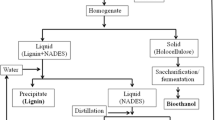Abstract
This review describes the utilization of paper sludge (PS), which is waste from the pulp and paper industry. Its advantages make PS the cellulosic biomass with the most potential for bio-refinery research and applicable for industrial scale. Some of the grain based biofuels and chemicals have already been in commercial operation, including fuel ethanol or biochemical products. Unfortunately, research and application of PS are yet in their infancy and suffer from large scale because of low productivity. Reviewing the many researches that are working at the utilization of PS for bio-refineries could encourage the utilization of PS from laboratory research to be applied in industry. For this reason, PS usage as industrial raw material will be effective in solving the environmental problems caused by PS with clean technology. In addition, its conversion to bio-ethanol could offer an alternative solution to the energy crisis from fossil fuel. Two methods of PS utilization as raw material for bio-ethanol production are introduced. The simultaneous saccharification and fermentation (SSF) using cellulase produced by A. cellulolyticus and thermotolerant S. cerevisiae TJ14 gave ethanol yield 0.208 (g ethanol/g PS organic material) or 0.051 (g ethanol/g PS). One pot bioethanol production as a modified consolidated biomass processing (CBP) technology gave ethanol yield 0.19 (g ethanol/g Solka floc) and is considered to be the practical CBP technology for its minimizing process.
Similar content being viewed by others
References
http://www.biomassenergycentre.org.uk/portal/page?_pageid=73,1&_ dad=portal&_schema=PORTAL.
http://www.nnfcc.co.uk/tools/international-biofuels-strategy-projectliquid-transport-biofuels-technology-status-report-nnfcc-08-017 (Evans, G. “International Biofuels Strategy Project. Liquid Transport Biofuels — Technology Status Report, NNFCC 08-017,” National Non-Food Crops Centre, 2008-04-14. Retrieved on 2011-02-16).
A. Idi and S. E. Mohamad, Interdisciplinary Journal of Contemporary Research in Business, 3, 919 (2011).
J. Prasetyo, J. Zhu, T. Kato and E.Y. Park, Biotechnol. Progr., 1, 104 (2011).
C. Moukamnerd, M. Kino-oka, M. Sugiyama, Y. Kaneko, C. Boonchird, S. Harashima, H. Noda, K. Ninomiya, S. Shioya and Y. Katakura, Appl. Microbiol. Biotechnol., 88, 87 (2010).
S. Macrelli, J. Mogenson and G. Zacchi, Biotechnology for Biofuels, 5, 22 (2012).
Y. Yamashita, C. Sasaki and Y. Nakamura, Carbohyd. Polymers, 79, 250 (2010).
J. Shen and F. A. Agblevor, BioprL. Biosyst. Eng., 34, 33 (2010).
S. Larsson, E. Palmqvist, B. Hahn-Hagerdal, C. Tengborg, K. Stenberg, G. Zacchi and N.O. Nilvebrant, Enzyme Microb. Technol., 24, 151 (1999).
T.D. Ranaatunga, J. Jervis, R. F. Helm, J. D. McMillan and R. J. Wooley, Enzyme Microb. Technol., 27, 240 (2000).
http://infohouse.p2ric.org/ref/12/11563.pdf (K. C. Das, E.W. Tollner, Georgia Univ. Experiment, Athens, Georgia. Retrieved on 2nd October 2012).
J. Prasetyo, N. Kazuya, T. Kato, C. Boonchird, S. Harashima and E. Y. Park, Biotechnol. Biofuels, 4, 35 (2011).
T. Ando, T. Sakamoto, O. Sugiyama, K. Hiyoshi, N, Matsue and T. Henmi, Clay Sci., 12, 243 (2004).
L. R. Lynd, K. Lyford, C. R. South, P.G. van Walsum and K. Levenson, TAPPI J., 84, 50 (2001).
http://ec.europa.eu/environment/waste/studies/compost/landspreading.pdf.
A. T.W. N. Hendriks and G. Zeeman, Bioresour. Technol., 100, 10 (2009).
J. Nielson and J. Villadsen, Bioreaction engineering principles, Plenum Press, New York, 86–87 (1994).
A. Marsushika, H. Inoue, T. Kodaki and S. Sawayama, Appl. Microbiol. Biotechnol., 84, 37 (2009).
B. Erdei, Z. Barta, B. Sipos, K. Reczey, M. Galbe and G. Zacchi, Biotechnol. Biofuel, 3, 16 (2010).
Z. Fan, C. South, K. Lyford, J. Munsie, P.V. Walsum and L.R. Lynd, Bioproc. Biosyst. Eng., 26, 93 (2003).
http://www.energyproducts.com/Documents/SLUDGPA4a.PDF (K.M. Pope, Paper sludge-waste disposal problem or energy opportunity. Energy products of Idaho 1999. Retrieved in April 2009).
J. Prasetyo, T. Kato and E.Y. Park, Biomass Bioenergy, 34, 1906 (2010).
R. Lakshmidevi and K. Muthukumar, Int. J. Hydrogen Energy, 35, 3389 (2010).
Environment Agency, Paper sludge ash: A technical report on the production and use of paper sludge ash. The Old Academy, Banbury, Oxon, UK (2008).
D. Karcher and W. Baser, Paper mill sludge as a mulch during turf grass establishment, In: Clark JR, Evans MR, editors. Horticulture Studies, Fayetteville: Arkansas Agricultural Experiment Station, Research Series, 494, 67 (2002).
J. Zaldivar, J. Nielsen and L. Olsson, Appl. Microbiol. Biotechnol., 56, 17 (2001).
Y. Ikeda, H. Hayashi, N. Okuda and E.Y. Park, Biotechnol. Progr., 23, 333 (2007).
S. Kansarn, A novel concept for the enzymatic degradation mechanism of native cellulose by A. cellulolyticus, Shizuoka University Repository (SURE), 91, http://hdl.handle.net/10297/1453, School of Electronic Science Research Report 2002, 23, 89 (2002).
P. Bansal, M. Hall, M. J. Realff, J.H. Lee and A. S. Bommarius, Biotechnol. Adv., 27, 833 (2009).
I.D. L. Mata, P. Estrada, R. Macarron and J.M. Dominguez, Biochem., 283, 679 (1992).
J. Prasetyo, S. Sumita, N. Okuda and E.Y. Park, Appl. Biochem. Biotechnol., 162, 52 (2010).
http://www.bioteach.ubc.ca/Biopersonalities/BioTechnologyLab/ellis.pdf.
A. V. Gusakov and A. P. Sinitsyn, Biotechnol. Bioeng., 40, 663 (1992).
P. A.M. Claassen, J. B. van Lier, A. M. L. Contreras, E.W. J. van Niel, L. Sijtsma, A. J.M. Stams, S. S. de Vries and R. A. Weusthuis, Appl. Microbiol. Biotechnol., 6, 741 (1999).
B. D. Solomon, J. R. Barnes and K. E. Halvorsen, Biomass Bioenergy, 6, 416 (2007).
L.R. Lynd, P. J. Weimer and W. H. van Zyl, Microbiol. Mol. Biol. Rev., 66, 506 (2002).
L.R. Lynd, W. H. van Zyl, J. E. McBride and M. Laser, Curr. Opin. Biotechnol., 16, 577 (2005).
S.U. Lee, K. Jung, G.W. Park, C. Seo, Y. K. Hong, W. H. Hong and H. N. Chang, Korean J. Chem. Eng., 29, 831 (2012).
Author information
Authors and Affiliations
Corresponding author
Rights and permissions
About this article
Cite this article
Prasetyo, J., Park, E.Y. Waste paper sludge as a potential biomass for bio-ethanol production. Korean J. Chem. Eng. 30, 253–261 (2013). https://doi.org/10.1007/s11814-013-0003-1
Received:
Accepted:
Published:
Issue Date:
DOI: https://doi.org/10.1007/s11814-013-0003-1




